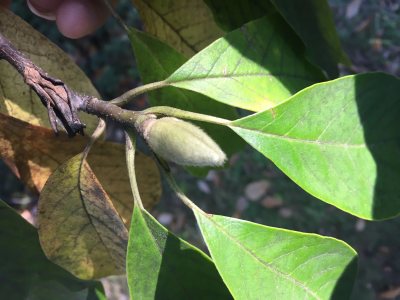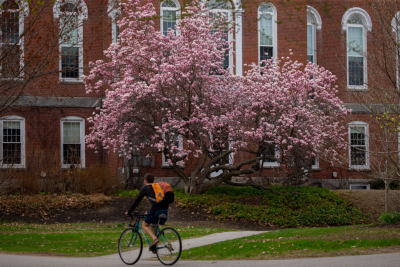Saucer Magnolia
Magnolia x soulangeana | Family: Magnioliaceae
Submission: Ruth A. van Kampen ‘19
Natural History:
Imagine your favorite tree. Wouldn’t it be nice to see that tree in every yard on your street, or in front of your favorite building in your hometown? Now imagine going door-to-door, trying to convince all of your neighbors to plant this tree in their yard. Doing so much work for just a tree may seem absurd even to an amateur dendrologist, let alone to a layperson who doesn’t know the first thing about trees. For Laura Dwight in the 1960s, this wasn’t the least bit out of the question.
Dwight’s tree of choice was saucer magnolia (Magnolia x soulangeana), which is a hybrid between M. heptapeta and M. liliflora, first crossed in the early 1800s by Chevalier Etienne Soulange-Bodin, the Director of the French Royal Institute. This hybrid is now very commonly seen as an ornamental, planted on campuses and in urban areas, due to its extremely tolerant and pest resistance. The leaves are deciduous, obovate to oblong (egg to oval-shaped), with rounded, wavy edges. The cup-shaped flower is very large and showy and can be pink, white/cream, or gray. In the spring, the trees have a spectacular display of these large, beautiful flowers. Most ornamental tree species have beautiful blooms, but the saucer magnolia’s are unique in that they only bloom for a brief amount of time, and one must be quick to capture and appreciate their beauty.
Laura Dwight lived in the Back Bay neighborhood on Commonwealth Avenue in Boston, which was reportedly deteriorating in the 1960s. To beautify and inspire pride in the neighborhood amongst her neighbors, Dwight began a tree-planting campaign in 1963. She went door-to-door, asking her neighbors if they would plant a saucer magnolia in their yard. For a small sum of $8, one would receive the tree, materials to fertilize the soil of the yard, and labor to plant the tree from a local fraternity. Most of Dwight’s neighbors elected to participate in the tree-planting campaign. Now, in 2017, these magnolias still occupy the front yards of the buildings in the Back Bay neighborhood and bloom faithfully every spring, coaxing the Northeastern city out of a long and hard winter.
Identification:

Leaves – Deciduous, alternate, simple leaf arrangement, obovate to oblong in shape, entire, undulate margins, pinnate venation.
Flowers – Large, cup-shaped, pink, very showy.
Twigs – Brown twigs.
Buds – Large, pubescent buds.
Fruit – 1-3 inches, elongated, irregular dry/hard red fruit.
Bark – Smooth light gray.
Silvics – Grows best in moist, acidic and well-drained loams in part shade or full sun and is frequently used in urban areas and campuses and is adaptable to many conditions.
References:
Edward F. Gilman, D. G. W. 2015. Magnolia x soulangiana: Saucer Magnolia.
University of Florida IFAS Extension.
Gary L. Koller, M. A. D. May 1979. The Best Street Trees. Arnoldia 39:83-138.
Leet, J. 1988. Laura Dwight’s Magnolias. Arnoldia 48:17-25.
Magnolia x soulangeana. Missouri Botanical Garden.Web. Accessed Nov. 1, 2017.
